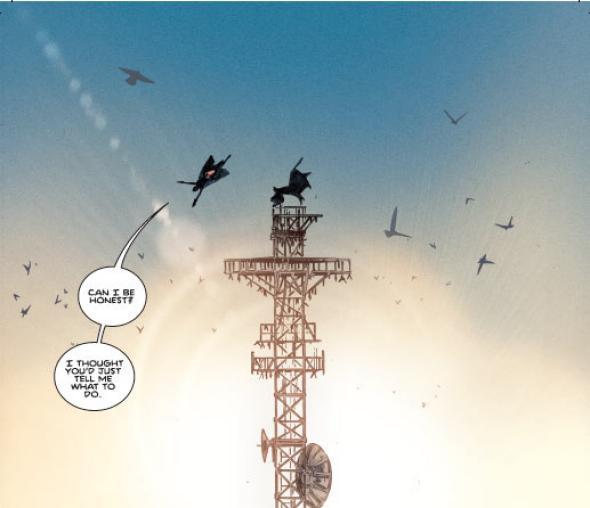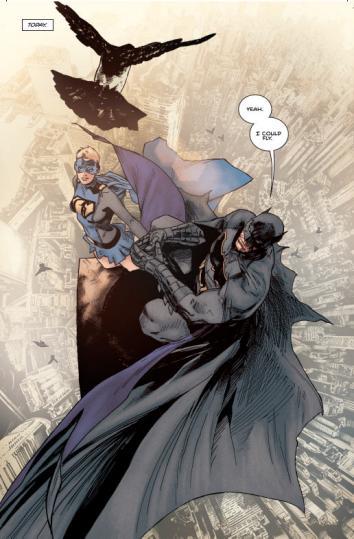How Does a Batman Comic Book Inker Work?
Artist Seth Mann talks about adding detail and texture to superhero illustrations.
Listen & Subscribe
Choose your preferred player:
Get Your Slate Plus Podcast
If you can't access your feeds, please contact customer support.
Listen on your computer:
Apple Podcasts will only work on MacOS operating systems since Catalina. We do not support Android apps on desktop at this time.
Listen on your device:RECOMMENDED
These links will only work if you're on the device you listen to podcasts on.
Set up manually:
Episode Notes
This season on Working, we’re talking to the people who make Batman comics, leading you through the artistic production process.
For this episode, which you can listen to via the player above, we spoke with inker Seth Mann. What, you might ask, does an inker do, exactly? Great question!
In Kevin Smith’s 1997 film Chasing Amy, a comic artist played by Jason Lee struggles to explain his contributions to the book he helps illustrate. “Holden draws the pictures in pencil and then he gives it to me to go over in ink,” he tells a cantankerous fan who dismissively responds, “So, basically you just trace.” Though Lee clarifies (“I add depth and shading to give the image more definition”), the fan is unrelenting. Before long, the two are literally at one another’s throats.
Trying to lay out his own responsibilities, Mann falls back on that scene. “Traditionally, it was so you could reproduce line art from pencils,” he says when I ask him what an inker does. “You just straighten up, tidy up, add some textures.” After a moment, though, he admits that it can be difficult to describe the particulars: “It’s a hard question to answer. I would say go watch Chasing Amy.”
Are inkers really just tracers, though? They’re not: Remember that in our previous episode, penciler David Finch claimed that his art isn’t complete until his own inker—typically Danny Miki—has had a crack at it. Still, Mann is just a bit more amenable to the “tracer” accusation than Lee’s character. “It just depends who you’re working with,” he says.

In his own professional comics life, Mann has worked exclusively with one penciler: his identical twin brother, Clay Mann. Together, the two have worked on books for comic publishers such as Marvel and Valiant, but more recently they’ve been contributing art to writer Tom King’s run on Batman, including a recent story about Kite Man, one of King’s favorite villains. They also worked on the issue in which our hero proposes to Catwoman, which we also discussed in previous episodes.
Where a good relationship between a penciler and an inker is always a matter of trust, the Manns are almost certainly closer than most. In fact, Clay typically delivers his pages directly to his brother, who then works on them in the evenings and over the weekend. (Seth is a high school teacher by day.) Clay sometimes consults with his brother while he’s still planning a page, giving their collaboration a truly conversational tenor. When deadlines are tight, the two have even worked together in the same studio, with Clay passing pages off to Seth before all the pencils are fully finished.
As that Chasing Amy scene suggests, no matter how important their role in the production process, inkers tend to receive less notice from comic book readers than the writers and pencilers who precede them. In Seth’s case, that takes on an unusual quality thanks in part to his resemblance to his brother. “At the conventions, they think I’m Clay,” he says. Would he ever really pretend to be his twin? Never. As an ardent comic fan in his own right, he has strong feelings about the importance of meeting the creators you admire, and as he puts it, “I’m not one that they’re generally after.”
It can be difficult, he admits, to sort out his feelings about that benign neglect, since so much of it is tied up in the fans’ admiration for his brother. He’s comfortable with his professional lot in life, though—not least of all because he’s long admired the work of other inkers. Growing up as a comic book fan, however, he was aware of their contributions to the stories he read. If his own experiences are frustrating, it’s mostly because he wishes the readers recognized his own contributions.
“It’s just like, how do these people not know what I do and how hard I work?” Mann wonders. But he also recognizes that similar dynamics also play out elsewhere within the collaborative process of comic production. “I’ve talked to artists who work with writers,” he says. “Someone will get the writer to sign the book, and then they’ll pass over the artist because they’re just there for the writer. It just depends on which part of the manufacturing belt you’re part of.”
To really understand what Seth brings to his brother’s art, though, you have to hear him talk about the tools of his trade. “I use anything,” he says. “I really like any time I use a dry brush. It just looks like rough ink on the page. It adds texture.” That’s evident throughout much of the proposal issue, where he employed the technique to contour bodies and create flares of light. But when it comes to it, he claims he’ll use almost any tool—“anything I can successfully use to get the mark I want on paper.”

Now and then, that willingness to test out what comes to hand has gotten him into trouble, though it’s always the kind you can fix. Discussing a full-page splash panel in the proposal issue, he says, “There’s a bird in the foreground, in the top left. [That’s] my lunch hour bird. I think I had left my stuff at home.” Having left his usual tools at home, he ended up taking a pass at the animal with what he thinks was a Bic pen and “a Crayola blackline marker,” making a mess of the design in the process. He ended up patching his mistake over with another piece of paper and reworking the section. Clay, Seth says, seemed disappointed when he realized what had happened: “He didn’t say much, because … the deadline on that book was really tight, so I think he forgave me.”
Or maybe one twin forgave the other because the final illustration is so perfectly executed. At first, the Manns’ bird almost resembles a Rorschach blot, an idle splash of suggestive nonsense. But as you examine it, its shape takes on a more objective clarity. Feathers emerge from the patchy black, and in the delicate shades of Seth’s inks, you can see the angle of its head. It is staring down at Batman on the building below. He is staring back. He seems to appreciate what he sees.
In a Slate Plus extra, Seth Mann talks about his connection to Magnum P.I. and talks about his high school students’ feelings about his comics work. If you’re a member, enjoy bonus segments and interview transcripts from Working, plus other great podcast exclusives. Start your two-week free trial at Slate.com/workingplus.